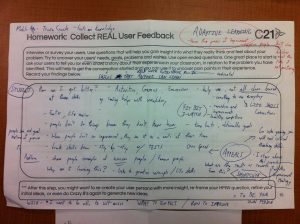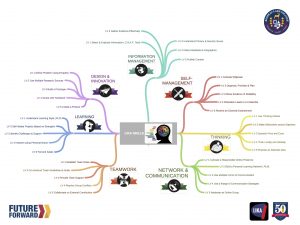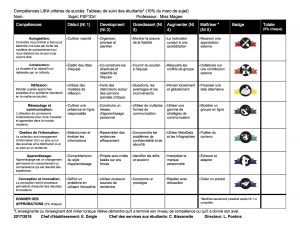FULL DISCLOSURE: (this post was first written, like, months ago, and then not published, and then completely abandoned, and now, in desperation to publish something, published; still not sure on the why, nevertheless working on the how!)
When you blow-up any traditional concept, in education or otherwise, there is always the inherent danger the pieces of your good intentions may become scattered and disconnected from the whole. Another way of saying this is, if you are not careful, you may lose your audience. Or in this case, your student? Or, as Australians are prone to say— the proverbial plot!
In my over ten years of teaching, I have found that educators typically fall into two somewhat contradictory mindsets: those who feel strongly we are preparing students for the harsh realities of the world, and those who believe students are the ones who will create their own brave new world. Did you notice the subtle yet fundamental difference there? One proposes to enrich a generation with the passed-down tools of success, the other prefers to engender resilience through autonomy. I am willing to admit that over the years I have found myself on both sides of this debate. I don’t believe either stance is necessarily the correct one. In fact, I am almost certain you need both of them in order to improve student engagement and achievement, in order to make education relevant again.
In my last post, I began the process of describing the intentions and HMW questions behind my Action Research Plan. To quote George Lucas, creator of Star Wars, who we are perhaps only now recognising will go down in history as the Charles Dickens of the 20th century or at the very least the John D. Rockefeller, “ideas are cheap”. What he meant by this, in spite of his billion-dollar Disney payout, is that anyone can have a good idea, but only the intrepid few can make it past the initial wonder-wall of sticky-note brainstorming and into the deadline-centric prototyping arena.
I am not usually one of those intrepid few. But I know a few people who are, and that has made all the difference.
THOSE NEXT STEPS
There have been plenty. Too many. I should have a pedagogical Fitbit for this.
Let us speed-date our way through this Escher. First, there was the User Feedback. I interviewed a student and a teacher, both of whom would benefit from this initiative. Here are some student thoughts around the why and how of skill development:
At one point I even had a few students on board to create a critical thinking APP. That idea quickly died when we all realised no one knew the first thing about designing an APP. But boy, let me tell you the excitement in the room….
So from those very positive user comments (suggesting I was indeed heading in the right direction) I created a mindmap version of the 7 LIKA Skills which our school has already subscribed to (Self-Management, Thinking, Network & Communication, Teamwork, Learning, Design & Innovation, Information Management). You will notice that a Levelling-Up strategy was initiated with each skill unfolding into a series of 5 increasingly challenging competencies. Not quite the Nintendo-style edtech “game” I had imagined, but nevertheless, something to aspire to. And quite pretty I might add (thank you coggle.it!)
Earlier in the year, I adjusted the achievement chart at our school for all subsequent assessments to cater for a Level 5 (instead of 4+, because, hey, it’s Level 5!). I then added Quality Descriptors so that our progress reports became gradeless and work habits could now be labelled as either Beginning, Developing, Deepening, Enhancing, or Mastering.
It made sense, to me at least, for our 21st Century Skills to follow a similar success criteria.
But it wasn’t enough. How would the unpacking of this work in the classroom? Or if not the classroom, where and when would teachers guide students through these 7 skills with 5 Levels each (that’s 35 separate competencies if you’re counting). Most importantly, how would they be assessed?
Then an idea hit me after the last Cohort21 meeting on Mars. The Parlay start-up boys that spoke to our whole group had an interesting functionality on their collaborative online forum— that of endorsement!
I would get the students to track their own skill development and ENDORSE others in the class who had likewise achieved a Level-Up. So that graphic looked like this:
I still needed the teacher to be somewhat accountable for this (without it being onerous) so a class tracking sheet for the teacher was also created. It looked like this:
I then spent too much time thinking about whether or not students would even be motivated to Level-Up on their own. I toyed with the idea that we should perhaps be giving some marks for soft skills, after all, there is a very good argument that all of these can be cultivated through each subject area and often make up a significant component any curriculum document (read your first 15 pages if you don’t believe me). But Should that be 5% of their final mark, 10%?
What if each student in the class started with a baseline 50% and then was given 5% for each skill they obtained and/or each endorsement? They wouldn’t be required to complete all 35 LIKA Skills, just 5 skills and 5 endorsements in order to reach 100%.
It wasn’t until a particularly poignant Google Hangout call with some Cohort21 alumni members that convinced me the road to success is not paved with extrinsic motivation. I couldn’t slide back into marks after having called for their exile! There would have to be another way!
While I was waiting for this other way, I asked our French teacher to get the kids to help them translate our new skills chart into French. It was a cool distraction, and resulted in this:
And so… HERE IS WHERE I AM! This is where my bitumen-paved butt hits gravel…. for a limited time only.
As the teaching faculty at my school and I prepare ourselves for another whole-school initiative (DISCOVERY DAYS, don’t ask, but please, ask?), I decided it was too much, too soon to unleash this particular 21st Century Skills beast on them. I wouldn’t say I’ve shelved it insomuch as I’ve merely back-burnered it for later in the year.
A few ideas that have recently hit me regarding the use and assessment of these skills:
- perhaps they are used as a way to strengthen abilities for student passion projects instead of assessed by each teacher in their subject areas
- explicitly taught and tracked by mentors
- LV 5 badges attached to high school transcript
REFLECTION
There is another difference I’ve noticed over the years, regarding how teachers conduct themselves in the workplace. There are those teachers who would like to be told exactly what to do, and there are those who work best when left alone to do their own thing. Again, at various points in my career, I’ve found myself on both sides of this professional fence— very often dependent on the workload, one doesn’t always have time to play in the clouds when all you can do most days is survive unscathed.
We are lucky to be engaged in a profession where we are, to a certain degree, responsible only to ourselves, our own individual classrooms, our own knowledge and expertise, our students. I cherish this about teaching. I have also, only just this year, understood the vital importance of networking and collaboration in my reflective practice. Cohort21 is the first time in my professional life I’ve felt this way.
A huge thanks to @ddoucet, @shelleythomas, @jsmith, @brenthurley, @jweening, @egelleny, @timrollwagen, @Think_teach, @jmedved, @lesmcbeth and others I may have failed to mention, for their continued assistance, guidance, ENDORSEMENT, and encouragement.
Finally, a non-baby-boomer PD! Cohort, you make me feel 21 again!






Thanks for the update, @edaigle! Please tell me more about discovery days at Rosseau Lake!
@edaigle You continue to inspire me with these posts!